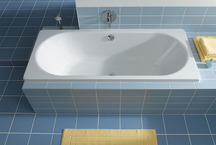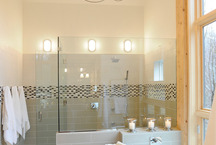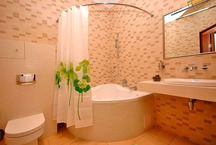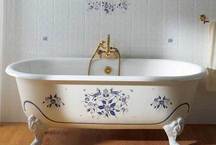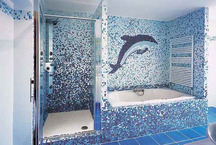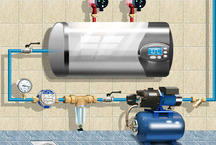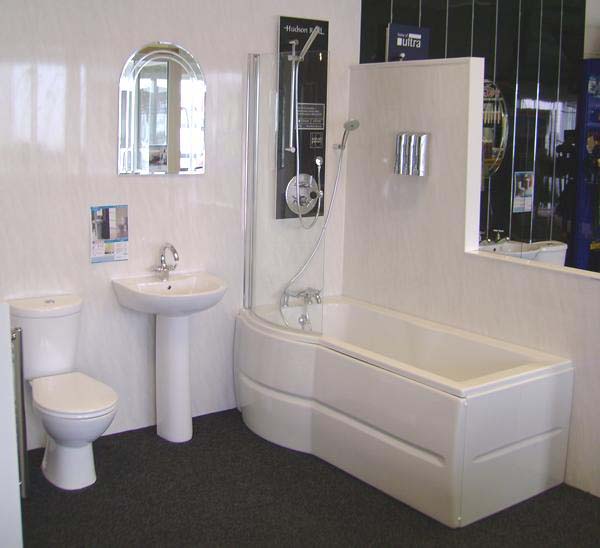
Photo: www.businessmagnet.co.uk
- first, most often such a room is small in size and volume, but even the ventilation in it does not allow the air to instantly get rid of the water vapor with which it is saturated when using hot water;
- secondly, there are usually quite a lot of different pipes (sewer riser, plumbing), especially if the bathroom is combined with a toilet;
- thirdly, in a small space, in addition to the bathroom and the washbasin, a washing machine is also often installed, as well as a tank for dirty laundry.
All these features of the bathroom for a long time limited the list of materials used for its decoration. More precisely, the material was one — ceramic tiles, which had replaced the plaster three to four decades ago, protected from water by oil paints.
However, progress does not stand still, now besides tiles you can use a mosaic, natural stone or, for example, paint the walls with moisture-resistant latex paint.
But the cheapest and fastest option is plastic panels.
The advantages of PVC panels
The main advantage of plastic panels, thanks to which they and steel are so popular finishing material for bathrooms - this is their moisture resistance. PVC panels do not just not get wet (and, consequently - and are not deformed), but also because of the presence of special "locks" that allow to connect them into a single solid canvas, do not allow moisture to penetrate beyond their plane. That is, the walls and ceiling, finished with this material, will remain dry and will not be exposed to a variety of fungi and mold.
The second advantage of PVC panels is their the cost. Of course, there is a certain variation in prices (the cost depends on the presence or absence of the pattern, the manufacturer, as well as the number of intermediaries gradually increasing the price until the material reaches you from the manufacturer), but almost always the price for 1 square meter of the panel will be a half- two times less than the cost of ceramic tiles.
In addition, the installation of PVC panels will cost much cheaper than laying tile.
The third virtue is this stuff. easy to mount independently both on walls, and on a ceiling, even without having experience. At the same time installation takes less time than laying tile.
Fourth - variety of colors, allowing to create any interior design of a bathroom. If desired, panels of two different colors (of identical thickness) can be docked both vertically and horizontally.
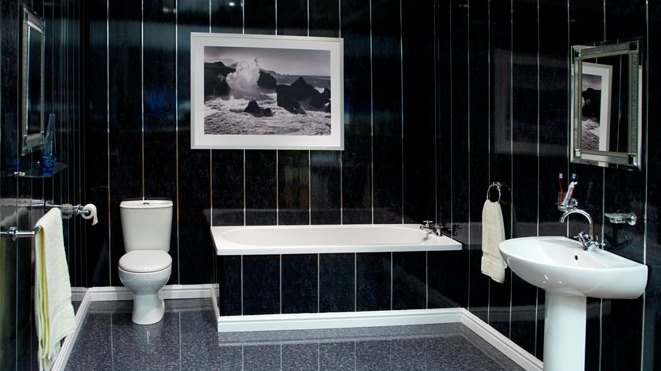
The fifth virtue is between the wall and the plastic panels. easy wiring (but it is better to hide it in a non-combustible and waterproof box or pipe).
The sixth is durability. Manufacturers guarantee the durability of the material for at least 15 years, and, as practice shows, most owners do the repairs in the bathroom every 10-15 years.
Seventh, PVC panels are easily cut into elements of the required length and width, so they "Fit" into the room of any configuration. At the same time, it is easy to make a box out of them, closing pipes and risers going from the lower to the upper floors and passing through your bathroom.
The eighth virtue - plastic panels are suitable for finishing ceiling bathroom so for wall cladding. However, unlike ceramic tiles, the initial flatness of the surface of the walls and ceiling (as well as the presence or absence of plaster and paint) does not matter, as the panels are mounted on the batten away from the surfaces.
Ninth - PVC panels not afraid of mold and are not the material on which this mold likes to appear.
Tenth - ease of cleaning bathroom. Care will be to periodically wipe the walls with a slightly damp cloth, without using detergents. Dishwashing detergents can be used to remove heavy dirt.
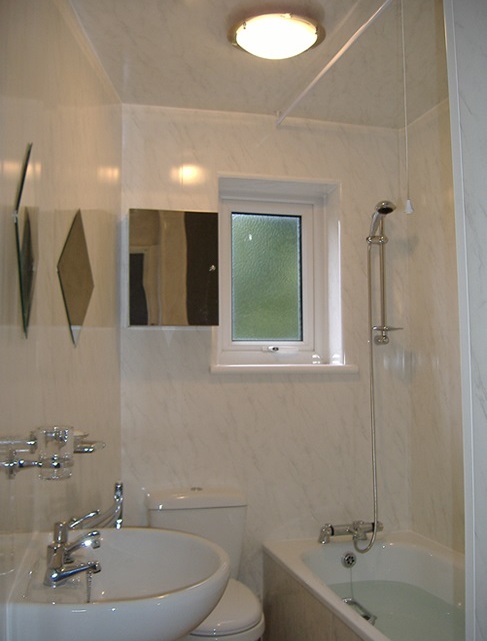
Eleventh virtue - PVC panels temperature fluctuations are not terrible in the bathroom. When heated and then cooled, they do not deform and do not lose their brightness.
disadvantages
Unfortunately PVC panels will not serve you for ages. Their lifetime limited for a period of 15-25 years, after which the plastic from which they are made will “grow old” and become more fragile. The destruction of its monolithic surface will lead to the evaporation of harmful substances into the bathroom.
In addition, since the plastic panels are mounted on the guide rails, some space remains between them and the wall (or ceiling). In such places, the strength of the entire canvas of panels depends only on the rigidity and quality of the panels themselves. Therefore, from accidental blows dents may appear.
Another unpleasant moment is manifested in the case flooding you neighbors from the top floor. Since the panels do not get wet, and when finishing the ceiling they are assembled into a single structure, all the water that falls under them will not have access to the outside. Therefore, the drying of the floor slab and the walls (from the ceiling, the water will flow further down them) will stretch for a very long time, during which a mold will have time to appear under the panels, and the plaster (if it exists) will partially peel off. Although from the front side (that is, from the inside of the bathroom), this whole process will be invisible.
PVC panels options
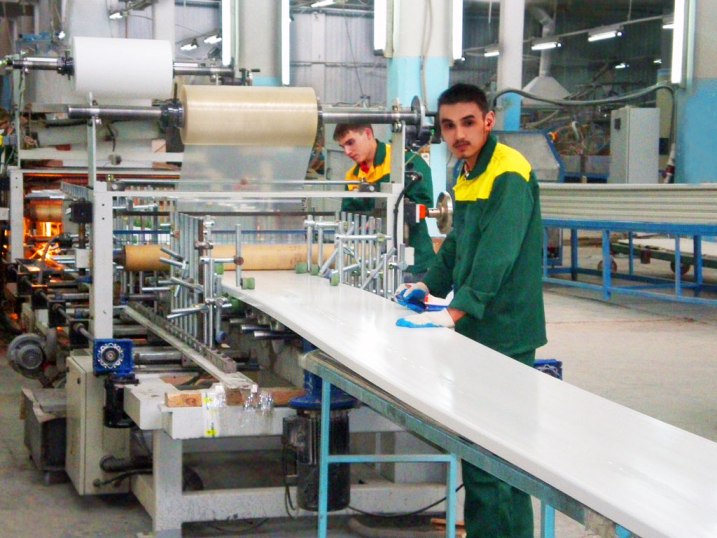
Photo: www.deko-plast.ru
PVC panels are made of polyvinyl chloride by pushing the source material, which is in a liquid state, through a special forming hole (this method is also known as “extrusion”). The resulting internal air gaps greatly facilitate the weight of the product, while the remaining cells filled with polyvinyl chloride serve as a kind of frame, giving the panels rigidity and strength.
The appearance is influenced not only by the production method, but also by their purpose, as well as the need to create a material convenient for transportation and installation in confined spaces of the room.
Therefore, PVC panels (regardless of their external colors), suitable for use in the bathroom, are available in the following sizes:
- width from 15 to 50 centimeters;
- length - 2.6 m, 2.7 m, 3 meters;
- thickness - 8, 9, 10 mm.
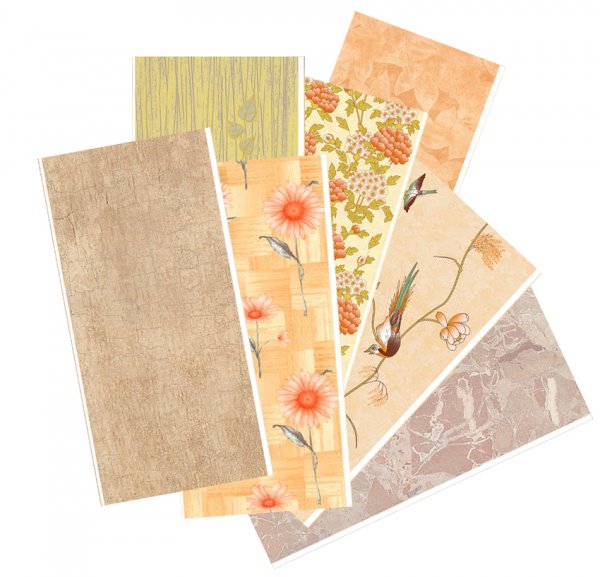
Photo: strport.ru
The appearance of the PVC panel depends on the method of applying the color coating during its production:
- pure white panel is the natural color of PVC, so there is no coating on them;
- Lacquered white panel is obtained by coating it with varnish, which gives it extra shine;
- a product with a pattern is created by thermal transfer, when a thermal film is applied to the panel with the corresponding images;
- “marbled” panels - in this case, the drawing is applied using a special shaft, when rolling on the surface, a result similar to typographic printing is obtained.
What you need to think in advance?
First, before installing the panels, be sure to treat the walls with a special primer - to prevent the appearance of fungus and mold.
Secondly, think about where the hangers, hooks, cabinets, electrical outlets will be located. In these places, you need to provide additional strips - to mount accessories and furniture then on them, and not on plastic.
Third, think about the wall insulation. For the bathroom under the plastic is best suited: extruded polystyrene (penoplex) or foil insulation based on polyethylene (for example, penofol). These two heaters do not absorb moisture.
Fourth, do not forget about ventilation.At contact of warm humid air with cold walls, the panels mist over, condensation forms on them. To reduce this effect in two ways - to make the walls warmer and reduce the humidity.
To reduce the humidity of the air, be sure to perform forced ventilation. Place the axial fan in the vent hole - it will accelerate the discharge of moist air from the bathroom.
Installation of plastic panels on the walls and ceiling
1. In addition to the panels themselves, you will need:
- knife for trimming panels;
- Ruler and pencil;
- plastic or metal guides for the device of the batten. Wooden bathroom should not be used - in case of water between the wall and panels they may swell, which will lead to deformation of the facing of the entire plane of the wall;
- self-tapping screws;
- screwdriver or screwdriver;
- building level;
- construction stapler;
- edging plastic profile of suitable color suitable for the selected thickness of PVC panels.
.jpg)
Photo: sibiropttorg.ru
2. Attach the guides to the walls horizontally, and to the ceiling - perpendicular to the chosen direction of installation of the panels, in increments of 50 centimeters. For fixing the guides are usually used screws. Extreme guides have: for the wall - near the floor and the ceiling, for the ceiling - about two opposite walls.
3. Attach the edging U-shaped profile to the ceiling and floor (for the wall) using self-tapping screws (25 cm pitch). This profile will hide the irregularities trim panel. The profile is attached not to the wall itself, but to the extreme guides.
4. Similarly, fasten the corner profile, designed to connect the panels in the corners of the room.
5. In the locations of lamps, furniture, hooks and sockets, the crate must be strengthened with additional elements.
6. Finishing the ceiling with plastic panels should be done after facing the walls. At the same time, it is better to adjust the height of the ceiling due to the thickness of the guides or “moving them away” from the ceiling plane with the help of small planks planted from the same material. The edges of the ceiling panels must be closed with special mounting skirting strips, which are interconnected by corners.
7. Installation can begin from any edge of the wall or ceiling. The most important thing is to gently bring the edge of the first panel into the edging profile. Attach the panel to the guides with a construction stapler or screws with a press washer.
8. Do not forget to immediately make holes for lamps, sockets, pipes and wires.
9. The last panel usually has to be cut to size (use a saw with fine teeth). Make the panel 2-3 mm less available space to make it easier to put in place.
